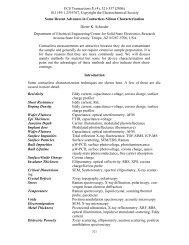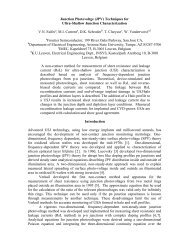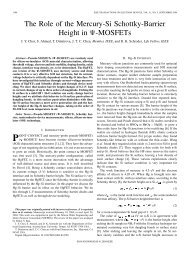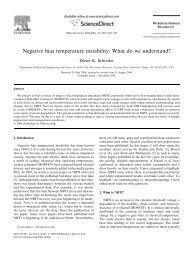Low-Frequency Noise in Near-Fully Depleted TFSOI MOSFET's
Low-Frequency Noise in Near-Fully Depleted TFSOI MOSFET's
Low-Frequency Noise in Near-Fully Depleted TFSOI MOSFET's
You also want an ePaper? Increase the reach of your titles
YUMPU automatically turns print PDFs into web optimized ePapers that Google loves.
BABCOCK et al.: LOW-FREQUENCY NOISE IN NEAR-FULLY-DEPLETED <strong>TFSOI</strong> MOSFET’S 41<br />
Fig. 2. Equivalent <strong>in</strong>put-referred gate noise power spectral density multiplied by frequency (SV G2 f ) versus measured frequency for a <strong>TFSOI</strong> n-channel<br />
MOSFET biased <strong>in</strong> both the subthreshold and saturation regions of operation. Inset shows gate SV G2 f versus measured frequency for a <strong>TFSOI</strong> p-channel<br />
MOSFET also biased <strong>in</strong> both the subthreshold and saturation regions of operation.<br />
at a constant of 0.5 and 1.0 V while the devices were<br />
operated <strong>in</strong> both the subthreshold and saturation regions of<br />
operation as a function of the gate voltage and threshold<br />
voltage difference. The dra<strong>in</strong> currents ranged from<br />
1.0 A to 16 mA for the n-MOS and from 4.0 A to 7.0 mA<br />
for the p-MOS, for these noise measurements. <strong>Noise</strong> <strong>in</strong> the<br />
l<strong>in</strong>ear region of operation was obta<strong>in</strong>ed by reduc<strong>in</strong>g to<br />
values less than<br />
measured at 1.0 Hz for the n-MOS transistor with<br />
different gate area is shown <strong>in</strong> Fig. 1 as a function of<br />
at a constant<br />
V. From these data, the <strong>in</strong>putreferred<br />
noise <strong>in</strong> the n-MOSFET is <strong>in</strong>dependent of gate<br />
bias condition when the channel is <strong>in</strong>verted [9]. We also see<br />
the expected dependence <strong>in</strong> the noise. In the<br />
subthreshold region of operation,<br />
, the noise at<br />
1.0 Hz <strong>in</strong>creases monotonically as is further decreased.<br />
The <strong>in</strong>crease <strong>in</strong> LF noise dur<strong>in</strong>g subthreshold operation is the<br />
result of G/R noise.<br />
This effect of G/R noise can be easily seen <strong>in</strong> Fig. 2<br />
where the <strong>in</strong>put-referred noise multiplied by the frequency<br />
is plotted versus frequency for a n-MOSFET<br />
[18], [19]. In saturation, is virtually <strong>in</strong>dependent<br />
of frequency. It can be <strong>in</strong>ferred that the noise <strong>in</strong> this region<br />
is composed primarily of “pure” noise with only m<strong>in</strong>or<br />
G/R noise present. However, when the device is operated<br />
<strong>in</strong> the subthreshold regime, we see the appearance of two<br />
dist<strong>in</strong>ct G/R noise centers, observed by the two Lorentzian<br />
shaped humps <strong>in</strong> the subthreshold noise, with<br />
Hz<br />
and<br />
kHz. It is clear that the G/R noise yields<br />
approximately an order of magnitude <strong>in</strong>crease <strong>in</strong> the total<br />
noise measured at 1.0 Hz, when compared to the “pure”<br />
noise produced <strong>in</strong> the saturation region of operation. If we<br />
extrapolate the fundamental noise <strong>in</strong> the subthreshold<br />
region to its 1.0 Hz value, we see that the bias dependence of<br />
this noise source is almost identical to the noise measured<br />
<strong>in</strong> the saturation region of operation. This is represented by the<br />
dashed l<strong>in</strong>e show<strong>in</strong>g noise <strong>in</strong> Fig 1.<br />
Similar bias dependence and noise characteristics were<br />
observed <strong>in</strong> the <strong>TFSOI</strong> surface-channel p-MOSFET’s as can be<br />
seen <strong>in</strong> the <strong>in</strong>set of Fig. 2. Fig. 3 compares the low-frequency<br />
noise measured <strong>in</strong> a p-MOS device to that <strong>in</strong> a n-MOS<br />
devices both operated at and V.<br />
The <strong>in</strong>creased noise level at 1.0 Hz for the p-MOSFET’s<br />
when compared to n-MOSFET’s is attributed to the exponent<br />
<strong>in</strong> the spectrum while the n-MOSFET’s showed<br />
<strong>in</strong> the spectrum. These results are similar to<br />
results we have obta<strong>in</strong>ed on bulk silicon surface-channel p-<br />
MOSFET’s [20]. As <strong>in</strong> the case of the n-channel device, the<br />
p-MOSFET’s showed enhanced noise when operated <strong>in</strong> the<br />
subthreshold regime. For the p-MOS devices the additional<br />
noise <strong>in</strong> the subthreshold region appeared as a shift <strong>in</strong> the<br />
noise power spectral density to <strong>in</strong> the spectrum<br />
at higher frequencies. However, below approximately 10.0 Hz,<br />
the noise was found to be <strong>in</strong>variant with the applied voltage<br />
when the p-MOSFET’s were operated <strong>in</strong> the saturation, l<strong>in</strong>ear,<br />
and subthreshold regions.<br />
The fundamental noise (before the onset of the k<strong>in</strong>k<br />
region,<br />
V) rema<strong>in</strong>ed bias <strong>in</strong>dependent both <strong>in</strong><br />
the saturation and l<strong>in</strong>ear regions of operation with only a<br />
slight <strong>in</strong>crease <strong>in</strong> G/R noise observed <strong>in</strong> the l<strong>in</strong>ear region<br />
of operation [13]. These results are consistent with those<br />
reported <strong>in</strong> bulk silicon where the equivalent <strong>in</strong>put noise<br />
shows only m<strong>in</strong>or variation with gate bias condition [17], [21].<br />
Because the equivalent <strong>in</strong>put noise conta<strong>in</strong>s a fundamental<br />
noise component that is <strong>in</strong>dependent of the applied voltage<br />
, we conclude that the LF noise sources <strong>in</strong> these








